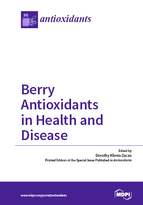Berry Antioxidants in Health and Disease
A special issue of Antioxidants (ISSN 2076-3921). This special issue belongs to the section "Health Outcomes of Antioxidants and Oxidative Stress".
Deadline for manuscript submissions: closed (30 June 2016) | Viewed by 118387
Special Issue Editor
Interests: berries; antioxidants; lipids; trace minerals; vascular function; inflammation; wound healing
Special Issues, Collections and Topics in MDPI journals
Special Issue Information
Dear Colleagues,
During the last decade, a high volume of work has been published on the health-promoting effects of berries (e.g., blueberries, cranberries, blackberries, etc.) that are high in antioxidant phytochemicals, polyphenols. Consuming diets high in polyphenols has also been documented to attenuate the risk of chronic diseases, such as cardiovascular disease, certain cancers, diabetes mellitus, and neurodegenerative disorders. Recent evidence also reveals that the biological effects of polyphenols extend beyond their traditional antioxidant role. This Special Issue will publish both reviews and original research papers on the role of berry antioxidants not only in maintaining health but also in preventing and/or reversing disease both in animal models and in humans. Additionally, the molecular mechanisms and signaling pathways engaged by berry antioxidants will be included.
Professor Dorothy Klimis-Zacas
Guest Editor
Manuscript Submission Information
Manuscripts should be submitted online at www.mdpi.com by registering and logging in to this website. Once you are registered, click here to go to the submission form. Manuscripts can be submitted until the deadline. All submissions that pass pre-check are peer-reviewed. Accepted papers will be published continuously in the journal (as soon as accepted) and will be listed together on the special issue website. Research articles, review articles as well as short communications are invited. For planned papers, a title and short abstract (about 100 words) can be sent to the Editorial Office for announcement on this website.
Submitted manuscripts should not have been published previously, nor be under consideration for publication elsewhere (except conference proceedings papers). All manuscripts are thoroughly refereed through a single-blind peer-review process. A guide for authors and other relevant information for submission of manuscripts is available on the Instructions for Authors page. Antioxidants is an international peer-reviewed open access monthly journal published by MDPI.
Please visit the Instructions for Authors page before submitting a manuscript. The Article Processing Charge (APC) for publication in this open access journal is 2900 CHF (Swiss Francs). Submitted papers should be well formatted and use good English. Authors may use MDPI's English editing service prior to publication or during author revisions.
Keywords
- Berries
- Polyphenols
- Flavonoids
- Anthocyanins
- Cardiovascular Disease
- Metabolic Syndrome
- Obesity
- Cancer
- Diabetes Mellitus
- Insulin Resistance
- Hypertension
- Neurodegenerative Disorders
- Inflammation
- Aging
- Gut Health and the Microbiome







